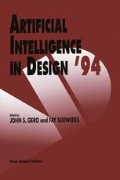Abstract
Analogical reasoning, it is commonly accepted, plays an important role in innovation and creativity. Since design often is innovative, and can be creative, the design task provides a good context for exploring the role of analogy in innovation and creativity. In the IDEAL project, we are exploring the processes of innovation and creativity in the context of conceptual (or preliminary, qualitative) design of physical devices. In particular, we are developing a model-based approach to innovation and creativity in analogical design: our core hypothesis is that innovative analogical design involves both reasoning from past experiences in designing devices (in the form of analogs or cases) and comprehension of how those devices work (in the form of device models or theories). In this paper, we focus on the issues of understanding feedback on the performance of a design, discovery of new design constraints, and reformulation of the design problem, and describe how the model-based approach addresses these issues.
Access this chapter
Tax calculation will be finalised at checkout
Purchases are for personal use only
Preview
Unable to display preview. Download preview PDF.
References
Barber, J., Bhatta, S., Goel, A., Jacobson, M., Pearce, M., Penberthy, L., Shankar, M., Simpson, R. and Stroulia, E.: 1992, AskJef: Integration of case-based and multimedia technologies for interface design support, in Gero, J. S. (ed.), Artificial Intelligence in Design ’92, Kluwer, Dordrecht, pp. 457–475.
Bhatta, S. and Goel, A.: 1993, Learning generic mechanisms from experiences for analogical reasoning, Proceedings of the Fifteenth Annual Conference of the Cognitive Science Society, Boulder, CO, pp. 237-242.
Bhatta, S. and Goel, A.: 1994 (to appear), Discovery of physical principles from design experiences, Special Issue on“Machine Learning in Design”, International Journal of AI EDAM (AI in Engineering Design, Analysis, and Manufacturing), 8 (2).
Brown, D. and Chandrasekaran, B., 1989: Design Problem Solving: Knowledge Structures and Control Strategies, Pitman, London, UK.
Bylander, T. and Chandrasekaran, B., 1985: Understanding behavior using consolidation, Proceedings of the Ninth International Joint Conference on Artificial Intelligence, pp. 450-454.
Gentner, D.: 1983: Structure-Mapping: A theoretical framework for analogy, Cognitive Science, 7: 155–170.
Gero, J.: 1990, Design prototypes: A knowledge representation schema for design, AI Magazine, 11(4).
Goel, A.: 1991a, A model-based approach to case adaptation, Proceedings of the Thirteenth Annual Conference of the Cognitive Science Society, Chicago, IL, pp. 143-148.
Goel, A.: 1991b, Model revision: A theory of incremental model learning, Proceedings of the Eighth International Conference on Machine Learning, Chicago, IL, pp. 605-609.
Goel, A. and Prabhakar, S.: 1991, A control architecture for model-based redesign problem solving, Proceedings of the IJCAI’91 Workshop on AI in Design, Sydney, Australia.
Huhns, M. and Acosta, E.: 1988, Argo: A system for design by analogy, IEEE Expert, Fall.
Maher, M. and Zhao, F.: 1987, Using experiences to plan the synthesis of new designs, in Gero, J. S. (ed.), Expert Systems in Computer-Aided Design, North-Holland, Amsterdam, pp. 349–369.
Marcus, S., Stout, J. and McDermott, J.: 1988, VT: An expert elevator designer that uses knowledge-based backtracking, AI Magazine, 9(1): 95–114.
McDermott, J.: 1982, R1: A rule-based configurer of computer systems, Artificial Intelligence Journal, 19: 39–88.
Mittal, S., Dym, C. and Morjaria, M.: 1986, PRIDE: An expert system for the design of paper handling systems, IEEE Computer, 19(7): 102–114.
Mostow, J., Barley, M. and Weinrich, T.: 1989, Automated reuse of design plans, International Journal of Artificial Intelligence and Engineering, 4(4): 181–196.
Navinchandra, D.: 1991, Exploration and Innovation in Design: Towards a Computational Model. Springer-Verlag, New York.
Pearce, M., Goel, A., Kolodner, J., Zimring, C., Sentosa, L. and Billington, R.: 1992, Case-based design support: A case study in architectural design, IEEE Expert, 7(5): 14–20.
Prabhakar, S. and Goel, A.: 1992, Using diagnostic experiences in experience-based innovative design, Proceedings of the Tenth SPIE Conference on Applications of Artificial Intelligence: Knowledge-Based Systems, Orlando, FL, pp. 420-434.
Qian, L. and Gero, J.: 1992, A design support system using analogy, in J. S. Gero (ed.), Artificial Intelligence in Design ’92, Kluwer, Dordrecht, pp. 795–813.
Sembugamoorthy, V. and Ghandrasekaran, B.: 1986, Functional representation of devices and compilation of diagnostic problem-solving systems, in Kolodner, J. and Riesbeck, C. (eds), Experience, Memory and Reasoning, Lawrence Erlbaum, Hillsdale, NJ, pp. 47–73.
Stroulia, E. and Goel, A.: 1992, Generic teleological mechanisms and their use in case adaptation, Proceedings of the Fourteenth Annual Conference of the Cognitive Science Society, Blooming-ton, IN, pp. 319–324.
Tong, C.: 1988, Knowledge-Based Circuit Design, PhD Thesis, Department of Computer Science, Stanford University.
Williams, B.: 1991, Interaction-based design: Constructing novel devices from first principles, Proceedings of IFIP International CAD conference, Columbus, OH.
Zhao, F. and Maher, M: 1992, Using network-based prototypes to support creative design by analogy and mutation, in J. S. Gero (ed.), Artificial Intelligence in Design ’92, Kluwer, Dordrecht, pp. 773–793.
Author information
Authors and Affiliations
Editor information
Editors and Affiliations
Rights and permissions
Copyright information
© 1994 Springer Science+Business Media Dordrecht
About this chapter
Cite this chapter
Bhatta, S., Goel, A., Prabhakar, S. (1994). Innovation in Analogical Design: A Model-Based Approach. In: Gero, J.S., Sudweeks, F. (eds) Artificial Intelligence in Design ’94. Springer, Dordrecht. https://doi.org/10.1007/978-94-011-0928-4_4
Download citation
DOI: https://doi.org/10.1007/978-94-011-0928-4_4
Publisher Name: Springer, Dordrecht
Print ISBN: 978-94-010-4400-4
Online ISBN: 978-94-011-0928-4
eBook Packages: Springer Book Archive

